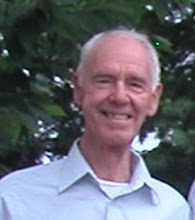One day we were in port, and the word came that Germany had surrendered. There was much rejoicing all the way around. But we still had a job to do, "unfinished business". Japan, in their entire history (which is much longer than ours), had never been defeated. And their philosophy was against it. "Death before dishonor". Their soldiers virtually never surrendered, but of course were sometimes physically captured. We all evisioned a fight to the very bitter end.
We did a lot of work on the ship to get it perfectly ready. One job I had was to paint the SK radar antenna. At that point I was the highest man on the ship, even over the Admiral, (Admiral Bill Holden, we were his flagship). Once we were in port, and several of us were way up there doing work on the SK antenna, and wouldn't you know it, they decided to get up a head of steam. Note that we were above the smokestacks in a not very environmentally friendly location. It got rather hot and thick up there. The Chief and I believe one other tech decided to sit it out. Not me. I took a deep breath, and climbed rapidly on Hot Rungs through a worse area of steam and smoke and then down into the clear and the deck. I asked the Chief later, and he said they just stayed there and "sucked it in".
Eventually it was time to head west to the "Western Sea Frontier", as the newspapers always termed it. On the way, we stopped at Mog Mog atol in the Marshall Islands, for not much more than over night. We went ashore and went swimming. Once we got under way again, we finally joined the Sixth Fleet as they were finishing their operations against Okinawa. They had earned a couple of weeks of rest and rehabilitation, and were now on the way down to Leyte in the recently recaptured Philippines.
I remember entering the Gulf of Leyte. There were a lot of very small uninhabited islands covered with trees. But the islands all had very high steep cliffs. Finally we got to Leyte itself. But far away from any city. We went ashore in what you could call an "enclave", just a beach, and a fence surrounding it. Through the fence the sailors traded with the native people, who appeared very intelligent, yet very poor but friendly.
After a while we put out to sea again. And on the Forth of July, I saw fireworks like I have never seen before or since. I was eye witness to the Sixth Fleet "flexing it's muscles". There were towed targets in the air and on the ocean. Both were attacked fiercely with lots of fire power. Most impressive were the rocket attacks on sea sleds used for targets.
We were on the way back up to operations, this time off the coast of Japan itself. I believe we cruised up and down about 200 miles off the coast. I do have a record of noontime positions of longitude and latitude for those months which I have kept in the "Topeka" book, but have never got around to plotting, but always wanted to some day. I remember seeing birds and sometimes even butterflys, off the coast of Japan. Also, I was able to pick up Mt Fujiyama on the SK radar.
Our task force included an aircraft carrier, our sister ship and maybe another cruiser or so, plus destroyers. Out about 50 miles there were destroyer escort "picket ships". The planes on the carrier would daily make bombing runs on the Japanese mainland. We had two seaplanes that were launched by steam catapult. The pilot would rev the engine up to the maximum, and the catapult, being angled some degrees off to the side, the ship heading into the wind, and then the catapult would fire. The plane would run down the catapult, get into the air, sag a bit, and then be on its way. Retrieval was a tricky business. We would head into the wind, then at just the right time, we would make a turn to smooth out the water for the plane to land on. It would land, taxi up to alongside the ship; a boom would lower a hook, and the pilot would reach out, grab the hook and thread it through a big steel "eye", and then the boom would hoist it back aboard.
The planes were supposed to be only for reconosance, but often they would come back and their guns had been fired. I think in at least one instance they were attacking a train.
The USS Topeka's main job was to protect the carrier.
Once one of the pilots of our seaplanes came in to land, but not quite right, and attempted to take off again but failed. He flipped over. When I saw him, he had only his shorts on, and was riding the pontoon of his plane like on horse back. The rest of the plane was under water. A motor whaleboat was launched, and he was rescued. The plane could not easily be retrieved, and was sunk by gunfire.
Well, I must go now. Next time I'll tell about our "anti-shipping sweep" into the entrace to Tokyo Bay.
Saturday, December 29, 2007
Subscribe to:
Post Comments (Atom)

No comments:
Post a Comment